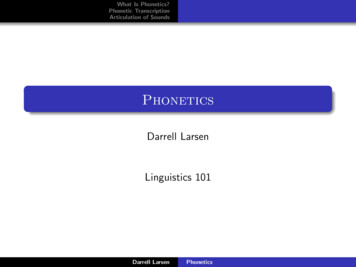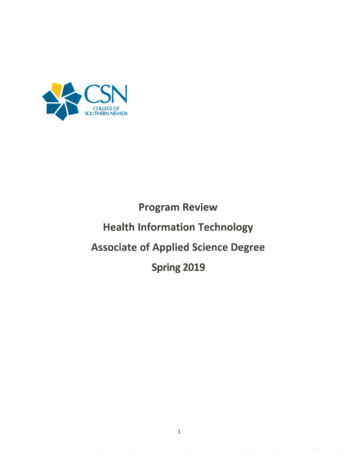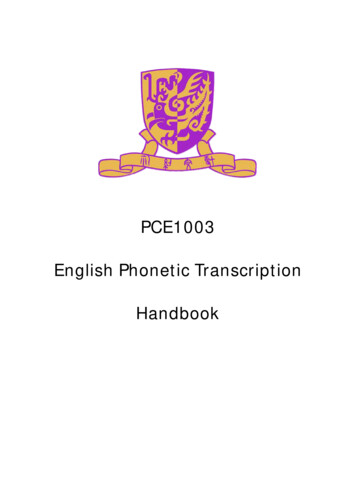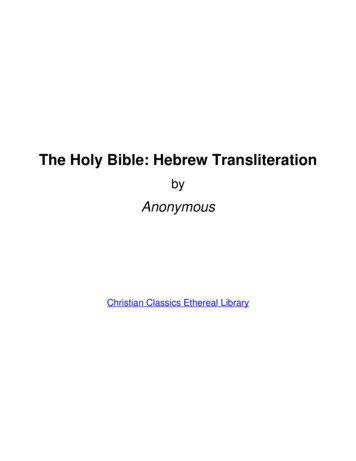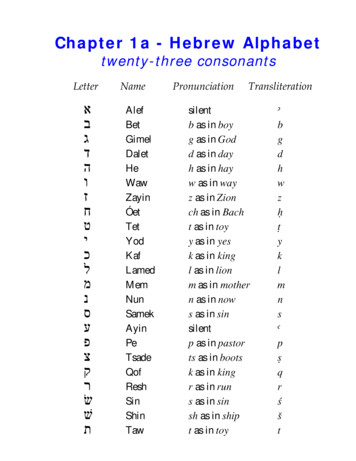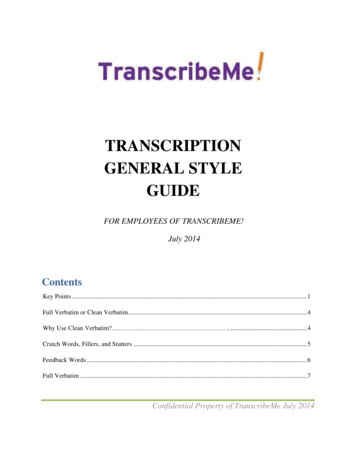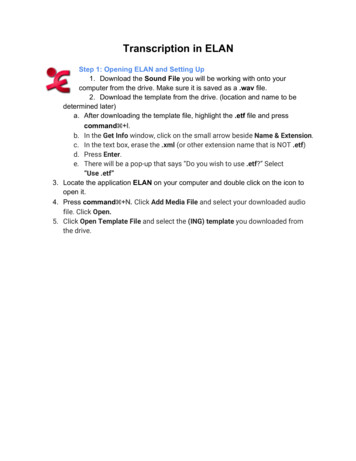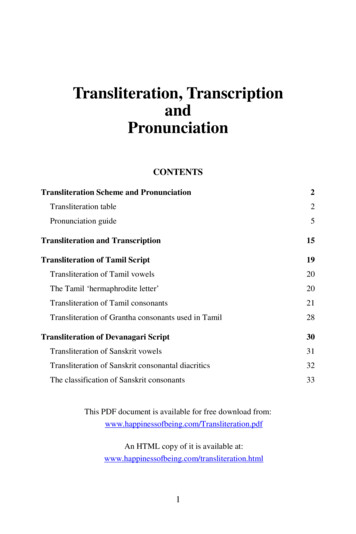
Transcription
Transliteration, on Scheme and Pronunciation2Transliteration table2Pronunciation guide5Transliteration and Transcription15Transliteration of Tamil Script19Transliteration of Tamil vowels20The Tamil ‘hermaphrodite letter’20Transliteration of Tamil consonants21Transliteration of Grantha consonants used in Tamil28Transliteration of Devanagari Script30Transliteration of Sanskrit vowels31Transliteration of Sanskrit consonantal diacritics32The classification of Sanskrit consonants33This PDF document is available for free download n HTML copy of it is available at:www.happinessofbeing.com/transliteration.html1
2Transliteration, Transcription and PronunciationTransliteration Scheme and PronunciationThe transliteration scheme that I use is based upon several closely relatedschemes, namely the International Alphabet of Sanskrit Transliteration(IAST), the scheme used in the Tamil Lexicon, the National Library atKolkata romanization scheme, the American Library Association and theLibrary of Congress (ALA-LC) transliteration schemes and the more recentinternational standard known as ‘ISO 15919 Transliteration of Devanagariand related Indic scripts into Latin characters’ (a detailed description ofwhich is available here).Transliteration tableThe following table summarises this transliteration scheme. In the firstcolumn I list all the diacritic and non-diacritic Latin characters that I use totransliterate the Tamil and Sanskrit alphabets, in the second column I givethe Tamil letter that each such character represents [followed in squarebrackets where applicable by the Grantha letter that is optionally used inTamil to denote the represented sound more precisely], in the third columnI give the Devanagari letter that it represents, and in the last column I givean indication of its pronunciation or articulation.In the Tamil and Devanagari columns, a dash (–) indicates that there isno exact equivalent in that script for the concerned letter in the other script.In the Tamil column, round brackets enclosing a letter indicates that it ispronounced and transliterated as such only in words borrowed fromSanskrit or some other language. Likewise, in the Devanagari column,round brackets enclosing a letter indicates that it is not part of the alphabetof classical Sanskrit, though it does occur either in Vedic Sanskrit or insome other Indian languages written in Devanagari.Vowels:a அअShort ‘a’, pronounced like ‘u’ in cutā ஆआLong ‘a’, pronounced like ‘a’ in fatheriஇइShort ‘i’, pronounced like ‘e’ in EnglishīஈईLong ‘i’, pronounced like ‘ee’ in seeu உउShort ‘u’, pronounced like ‘u’ in putū ஊऊLong ‘u’, pronounced like ‘oo’ in foodṛ–ऋShort vocalic ‘r’, pronounced like ‘ri’ in merrily
Transliteration, Transcription and Pronunciation3Long vocalic ‘r’–ऌShort vocalic ‘l’, pronounced like ‘lry’ in revelry (notto be confused with the Tamil consonant ள், which isalso transliterated as ḷ)ḹ–ॡLong vocalic ‘l’eஎ(ऎ)Short ‘e’, pronounced like ‘e’ in elseēஏएLong ‘e’, pronounced like ‘ai’ in aidai ஐऐDiphthong ‘ai’, pronounced like ‘ai’ in aisleo ஒ(ऒ) Short ‘o’, pronounced like ‘o’ in cotō ஓओLong ‘o’, pronounced like ‘o’ in doteau ஔऔDiphthong ‘au’, pronounced like ‘ou’ in soundConsonantal diacritics:ḵஃ–Tamil āytam, indicating gutturalization of thepreceding vowel, pronounced like ‘ch’ in lochṁ –ंSanskrit anusvāra, indicating nasalization of thepreceding vowel, pronounced like ‘m’ or (whenfollowed by certain consonants) ‘ṅ’, ‘ñ’, ‘ṇ’ or ‘n’ḥ –ःSanskrit visarga, indicating frication (or lengthenedaspiration) of the preceding vowel, pronounced like‘h’ followed by a slight echo of the preceding vowelConsonants:kக்क्Velar plosive, unvoiced and unaspiratedkh (க் )ख्Velar plosive, unvoiced but aspiratedg க்ग्Velar plosive, voiced but unaspiratedgh (க் )घ्Velar plosive, voiced and aspiratedṅ ங்ङ्Velar nasalcச்च्Palatal plosive, unvoiced and unaspirated(pronounced like ‘c’ in cello or ‘ch’ in chutney)ch (ச்)छ्Palatal plosive, unvoiced but aspiratedjச் [ஜ் ]ज्Palatal plosive, voiced but unaspiratedjh (ச்)झ्Palatal plosive, voiced and aspiratedñ ஞ்ञ्Palatal nasalṭட்ट्Retroflex plosive, unvoiced and unaspiratedṭh (ட் )ठ्Retroflex plosive, unvoiced but aspiratedḍ ட்ड्Retroflex plosive, voiced but unaspiratedṝḷ–ॠ
4Transliteration, Transcription and Pronunciationḍhṇtthddhnpphbbhmyr(ட் )ढ्ண்த்ण्त्(த் )थ्த்द्(த் )ध्ந்न्ப்प्(ப் )फ्ப்ब्(ப் ��) [ஶ]श्ṣ(ச்)ष्ழ்[ஷ் ]shச் [ஸ் ]க் [ஹ்]स्ह्Retroflex plosive, voiced and aspiratedRetroflex nasalDental plosive, unvoiced and unaspiratedDental plosive, unvoiced but aspiratedDental plosive, voiced but unaspiratedDental plosive, voiced and aspiratedDental nasalLabial plosive, unvoiced and unaspiratedLabial plosive, unvoiced but aspiratedLabial plosive, voiced but unaspiratedLabial plosive, voiced and aspiratedLabial nasalPalatal semivowelDental tap (in Tamil phonology) or retroflex trill (inSanskrit phonology)Dental lateral approximantLabial semivowelRetroflex central approximant (transliterated as ḻ inthe Tamil Lexicon, and commonly transcribed as zh)Retroflex lateral approximantAlveolar plosive, unvoiced (pronunciation of ற onlywhen it is muted, that is, not followed by a vowel)Alveolar plosive, voiced (pronunciation of ற onlywhen it follows ன்)Alveolar trill (pronunciation of ற when it follows andprecedes a vowel)Alveolar nasalPalatal aspirated sibilant, pronounced somewhat like‘s’ in sure (or ‘sh’ in she)Retroflex aspirated sibilant, pronounced somewhatlike ‘s’ in sure (or ‘sh’ in she), but with the tonguecurled further backDental aspirated sibilant, pronounced like ‘s’ in seeVoiced glottal fricative
Transliteration, Transcription and Pronunciation5Pronunciation guideIn the following guide to the pronunciation of Tamil and Sanskrit words asrepresented by this transliteration scheme, I will not venture to go too deepinto the science of phonetics, which is a subject of which my understandingis very limited, but will attempt to offer at least a simple guide.For those who wish to learn more about the phonetics of Tamil andSanskrit (and also their phonologies, scripts, transliteration, grammar andso on), there is abundant (but not always entirely reliable) informationavailable online, particularly in Wikipedia articles that can be accessedthrough the language portal such as Tamil language, Tamil phonology,Tamil script, Tamil grammar, Sanskrit, Vedic Sanskrit, Śikṣā (the scienceof Sanskrit phonetics), Grantha script, Devanagari script, Devanagaritransliteration and International Alphabet of Sanskrit Transliteration(IAST).More detailed information about phonetics in general (includingdetailed explanations of many of the technical terms that I have used here)is also available in Wikipedia and can be accessed through the index ofphonetics articles. In many of these articles the symbols of theInternational Phonetic Alphabet (IPA) are used, and a detailed list andexplanation of these symbols are given in the Wikipedia:IPA article, whichwill be helpful to anyone who wants to learn exactly how Tamil andSanskrit letters should be pronounced.Each diacritic mark used in this transliteration scheme indicates aspecific quality of pronunciation. A macron above any vowel (ā, ī, ū, ṝ, ḹ, ēand ō) indicates that it is long (and a breve above any vowel, such as ă, ĭ orŭ, indicates that it is particularly short, though it does not actually occur asa diacritic in this scheme). Except in the case of ḥ, which indicates that thepreceding vowel is aspirated, an underdot below any consonant (ṭ, ṭh, ḍ, ḍh,ṇ, ḷ and ṣ) or any ‘vowel’ (ṛ, ṝ, ḷ and ḹ) indicates that it is retroflex (as alsodoes the overdot above the Tamil consonant ṙ). A macron below anyconsonant other than ḵ (namely ṯ, ḏ, ṟ and ṉ) in a Tamil word indicates thatit is alveolar. An ‘h’ appended to any other consonant (kh, gh, ch, jh, ṭh,ḍh, th, dh, ph and bh) in a Sanskrit word indicates that it is aspirated.However, no such general rule applies to any of the other diacriticmarks, namely those on ḵ, ṁ, ḥ, ṅ, ñ, ṙ and ś, so I will explain below what
6Transliteration, Transcription and Pronunciationeach of them indicates while discussing each of these charactersindividually.Vowels:A short vowel is pronounced for a single unit of sound duration called amātra, and a long vowel or diphthong is pronounced for two such units.The first vowel, a (அ, अ), is pronounced like ‘u’ in ‘pun’ or ‘a’ in ‘above’,and ā (ஆ, आ) is the same sound pronounced twice as long, like ‘a’ in‘after’ or ‘father’. The next vowel, i (இ, इ), is pronounced like ‘i’ in ‘in’or ‘e’ in ‘English’, and ī (ஈ, ई) is the same sound pronounced twice aslong, like ‘ee’ in ‘see’. The next vowel, u (உ, उ), is pronounced like ‘u’ in‘put’, and ū (ஊ, ऊ) is the same sound pronounced twice as long, like ‘oo’in ‘food’. The next vowel in Tamil, e (எ), is pronounced like ‘e’ in ‘else’,and ē (ஏ, ए) is the same sound pronounced twice as long, like ‘ai’ in ‘aid’.Unlike Tamil, in Sanskrit there is no short e, but prior to the long ē (ए)there are four other vowels (though the last of these is only classified forthe sake of symmetry, since it is never actually used), namely ṛ (ऋ), whichis pronounced almost like ‘ri’ (as in ‘merrily’) or somewhere between ‘ri’and ‘ru’ (with a short ‘u’ as in ‘put’), ṝ (ॠ), which is the same soundpronounced twice as long (somewhat like ‘ri’ in ‘marine’), ḷ (ऌ), which ispronounced almost as ‘lri’ (like ‘lry’ in ‘revelry’), and ḹ (ॡ), which istheoretically the same sound pronounced twice as long.In both Tamil and Sanskrit, ē (ஏ, ए) is followed by the diphthong ai (ஐ,ऐ), which is pronounced like ‘ai’ in ‘aisle’. In Tamil this is followed by o(ஒ), which is pronounced like ‘o’ in ‘cot’, and then in both languagescomes ō (ஓ, ओ), which is the same sound pronounced twice as long, like‘o’ in ‘dote’. The final vowel is another diphthong, au (ஔ, औ), which ispronounced like ‘ou’ in ‘sound’.Consonantal diacritics:In Tamil the next letter is the ‘hermaphrodite’ āytam, ḵ (ஃ), which ispronounced somewhat like a guttural ‘k’, ‘g’ or ‘h’ (or ‘ch’ in the Scottishword ‘loch’) appended to the preceding vowel, and which only occursbetween a short vowel and one of the ‘hard class’ consonants.In Sanskrit the fourteen vowels are followed by two consonantaldiacritics, the anusvāra, ṁ (ं), which nasalises the vowel to which it isappended, and which may therefore be pronounced either like ‘m’ or
Transliteration, Transcription and Pronunciation7(when it is not at the end of a sentence) like any form of ‘n’, dependingupon which consonant follows it, and the visarga, ḥ (ः), which aspirates thevowel to which it is appended, and which is therefore pronouncedsomewhat like ‘h’, but often followed by a slight echo of the precedingvowel. Thus namaḥ is pronounced ‘namahă’, and śāntiḥ pronounced‘śāntihĭ’.Consonants:In Sanskrit the consonants begin with five groups of five stopconsonants (known in Sanskrit as sparśa or ‘touch’ consonants, since theyare formed by complete contact of the organs of utterance), each groupconsisting of four plosives (oral stops) followed by one nasal stop. Eachgroup of four plosives consists of a pair of voiceless (unvoiced or aghōṣa)and a pair of voiced (ghōṣa) consonants, and each pair consists of oneunaspirated (alpaprāṇa or ‘slight breath’) and one aspirated (mahāprāṇa or‘great breath’) consonant. Thus the order of plosives within each group isunvoiced and unaspirated, unvoiced and aspirated, voiced and unaspirated,and voiced and aspirated.In Tamil the consonants also begin with the same five groups of stopconsonants, but each group of four plosives is represented by a single letter(all of which are collectively known as the val-l-iṉam or ‘hard class’ ofconsonants). As I will explain in more detail in the section on thetransliteration of Tamil consonants, these five ‘hard class’ consonants (andthe sixth one, ṯ [ற் ], which is placed near the end of the Tamil alphabet)may be either unvoiced or voiced, because their exact pronunciation isdetermined by their position in a word and the letters that precede or followthem. In words of pure Tamil origin they are never aspirated, but inloanwords from Sanskrit and other languages they are aspirated whereappropriate. In the Tamil alphabet each of these ‘hard class’ consonants isfollowed by its corresponding nasal (which are collectively known as themel-l-iṉam or ‘soft class’ of consonants), so whereas Sanskrit has fivenasal consonants (ṅ, ñ, ṇ, n and m), Tamil has six (ṅ, ñ, ṇ, n, m and ṉ).With the exception of the sixth group of stop consonants in Tamil(namely ṯ [ற் ] and ṉ [ன்], which are alveolar and therefore belongphonetically between the third and fourth group, but which are placedseparately at the end of the Tamil alphabet), in both Sanskrit and Tamil the
8Transliteration, Transcription and Pronunciationfive groups of stop consonants are arranged phonetically according to theirplace of articulation, beginning from the back of the mouth (velar) andending with the lips (labial), so their sequence is velar (kaṇṭhya or‘guttural’), palatal (tālavya), retroflex (mūrdhanya or ‘cerebral’), dental(dantya) and labial (ōṣṭhya).Thus in both languages the first group of stop consonants are velar,which means that they are pronounced with the back part of the tongueagainst the velum (the soft palate at the back of the mouth). The first velarconsonant in both languages is k (க் , क्), which is an unaspirated andunvoiced plosive, pronounced like ‘k’ in ‘skip’ (though in Tamil க் canalso be pronounced as ‘g’ or ‘h’, according to the rules that I will explainlater in the section on the transliteration of Tamil consonants). In Sanskritthis is followed by three more velar plosives, the aspirated unvoiced kh(ख्), which is pronounced like ‘k’ but with a stronger exhalation (like themore strongly aspirated ‘k’ in ‘kip’), the unaspirated voiced g (க் , ग्),which is pronounced like ‘g’ in ‘game’, and the aspirated voiced gh (घ्),which is pronounced like ‘g’ but with a stronger exhalation. The finalconsonant in this group is the velar nasal, ṅ (ங் , ङ्), which is pronouncedlike ‘ng’ in ‘sing’.The second group of stop consonants are palatal, which means that theyare pronounced with the body of the tongue raised against the hard palate(the middle part of the roof of the mouth). The first palatal consonant inboth languages is c (ச், च्), which is an unaspirated and unvoiced plosive,pronounced like ‘ch’ in ‘church’ (though in Tamil ச் can also bepronounced as ‘j’ or ‘s’, according to the rules that I will explain in thesection on the transliteration of Tamil consonants). In Sanskrit this isfollowed by three more palatal plosives, the aspirated unvoiced ch (छ्),which is pronounced like ‘ch’ but with a stronger exhalation, theunaspirated voiced j (ச், ஜ் , ज्), which is pronounced like ‘j’ in ‘jug’, andthe aspirated voiced jh (झ्), which is pronounced like ‘j’ but with a strongerexhalation. The final consonant in this group is the palatal nasal, ñ (ஞ், ञ्),which is pronounced like ‘ni’ in ‘onion’ or ‘ny’ in ‘canyon’.The first of these palatal consonants, c (ச், च्), is often transcribed (bothin Tamil and in Sanskrit words) as ‘ch’, since it is pronounced like ‘ch’ inmany English words such as ‘chair’ (and also in ‘chutney’, which English
Transliteration, Transcription and Pronunciation9has borrowed from an Urdu and Hindi word, caṭnī), but its correcttransliteration is only ‘c’, since in all precise schemes for transliteratingIndic scripts the post-consonantal ‘h’ is reserved for indicating that theconsonant to which it is appended is aspirated. Therefore the transliteration‘ch’ represents the second of the Sanskrit palatal consonants (छ्), which isaspirated. Thus, though some frequently used Sanskrit words such asaruṇācala, cit and vicāra are commonly transcribed as ‘Arunachala’, ‘chit’and ‘vichara’ respectively, when transliterated precisely the ‘ch’ soundshould be represented by ‘c’.In Sanskrit a commonly occurring consonant cluster is jñ (for which theDevanagari character is ज्ञ्, which is a ligature of ज् [j] and ञ् [ñ]), but it isnot pronounced exactly as it is spelt. In north India jña (ज्ञ) tends to bepronounced like ‘gya’, whereas in south India when it occurs in initialposition (as for example in ज्ञान, jñāna) the j (ज्) is hardly pronounced(and hence in Tamil jñāna is spelt as it is pronounced, namely ஞானம்[ñānam]), whereas in the middle of a word (as for example in ajñāna orprajñāna) the j (ज्) is pronounced somewhat like g (which in Tamil isindicated by gemination of ஞ் [ñ], as for example in ajñāna, which is speltஅஞ்ஞானம் [aññānam]). In this respect jñ is similar to the cognatecluster ‘gn’ in English, because in initial position (as for example in ‘gnaw’or ‘gnosis’) the ‘g’ is silent, whereas in the middle of a word (as forexample in ‘agnostic’ or ‘diagnosis’) the ‘g’ is pronounced.The third group of stop consonants are retroflex (as indicated intransliteration by the diacritic underdot), which means that they arepronounced by curling the tip of the tongue back to point up towards (or inthe case of these stop consonants, to actually touch) the roof of the mouth,just behind the alveolar ridge (for which reason they are called in Sanskritmūrdhanya, ‘head’ or ‘cerebral’ consonants). When articulating any of thefive retroflex sparśa or ‘touch’ consonants (ṭ, ṭh, ḍ, ḍh and ṇ) or the Tamilretroflex lateral approximant, ḷ (ள்), the tip of the tongue actually touchesthe roof of the mouth, but when articulating Tamil retroflex centralapproximant, ṙ (ழ் ), or the Sanskrit retroflex sibilant, ṣ (ஷ் , ष्), no contactis made.The first retroflex consonant is ṭ (ட் , ट्), which is an unaspirated andunvoiced retroflex plosive, pronounced like an English ‘t’ but with the
10Transliteration, Transcription and Pronunciationtongue curled up (though in Tamil ட் can also be pronounced as ‘d’ withthe tongue curled up, according to the rules that I will explain in the sectionon the transliteration of Tamil consonants). In Sanskrit this is followed bythree more retroflex plosives, the aspirated unvoiced ṭh (ठ्), which ispronounced like an English ‘t’ but with the tongue curled up and with astronger exhalation, the unaspirated voiced ḍ (ட் , ड्), which is pronouncedlike an English ‘d’ but with the tongue curled up, and the aspirated voicedḍh (ढ्), which is pronounced like an English ‘d’ but with the tongue curledup and with a stronger exhalation. The final consonant in this group is theretroflex nasal, ṇ (ண், ण्), which is pronounced like an English ‘n’ butwith the tongue curled up.The fourth group of stop consonants are dental, which means that theyare pronounced with the tongue touching or close to the upper teeth (unlikethe corresponding consonants in English, which are pronounced with thetongue touching or close to the alveolar ridge, just above the upper teeth).The first dental consonant is t (த் , त्), which is an unaspirated and unvoiceddental plosive, pronounced like an English ‘t’ but with the tongue touchingthe teeth (though in Tamil த் can also be pronounced as ‘d’ with the tonguetouching the teeth, according to the rules that I will explain in the sectionon the transliteration of Tamil consonants). In Sanskrit this is followed bythree more dental plosives, the aspirated unvoiced th (थ्), which ispronounced like an English ‘t’ but with the tongue touching the teeth andwith a stronger exhalation, the unaspirated voiced d (த் , द्), which ispronounced like an English ‘d’ but with the tongue touching the teeth, andthe aspirated voiced dh (ध्), which is pronounced like an English ‘d’ butwith the tongue touching the teeth and with a stronger exhalation. The finalconsonant in this group is the dental nasal, n (ந் , न्), which is pronouncedlike an English ‘n’ but with the tongue touching the teeth.The fifth group of stop consonants are labial (or more precisely,bilabial), which means that they are pronounced with the lips. The firstlabial consonant is p (ப் , प्), which is an unaspirated and unvoiced labialplosive, pronounced like ‘p’ in ‘spun’ (though in Tamil ப் can also bepronounced as ‘b’, according to the rules that I will explain in the sectionon the transliteration of Tamil consonants). In Sanskrit this is followed bythree more labial plosives, the aspirated unvoiced ph (फ्), which is
Transliteration, Transcription and Pronunciation11pronounced like ‘p’ but with a stronger exhalation (like the more stronglyaspirated ‘p’ in ‘pun’), the unaspirated voiced b (ப் , ब्), which ispronounced like ‘b’ in ‘bat’, and the aspirated voiced bh (भ्), which ispronounced like ‘b’ but with a stronger exhalation. The final consonant inthis group is the bilabial nasal, m (ம் , म्), which is pronounced like anEnglish ‘m’.These five groups of stop consonants are followed by a group of oralsonorants that in Sanskrit are called antastha (antaḥ-stha), which means‘standing between’ (since they are sounds that considered to be standingbetween vowels and true consonants), and in Tamil are called the iṭai-yiṉam or ‘medial class’ of consonants. Since the Sanskrit term antastha issometimes translated in English as ‘semivowel’, this group of oralsonorants are often loosely described as semivowels, but they are moreaccurately described as approximants, because only two of them (y and v)are truly semivowels and the rest (r, l, ṙ and ḷ) are liquids.In Tamil there are six of these ‘medial class’ consonants (y, r, l, v, ṙ andḷ), but in Sanskrit there are only the first four members of this group. Thefirst of these is y (ய் , य्), which is the palatal semivowel (also called thepalatal approximant or palatal central approximant). The second is r (ர், र्),which according to Tamil phonology is a dental tap (though phonetically itis described as the alveolar tap), but according to Sanskrit phonology is aretroflex trill (though phonetically it is described as the alveolar trill). Thethird is l (ல் , ल्), which is traditionally described as the dental ‘l’ or dentallateral approximant (though phonetically it is described as the alveolarlateral approximant). The fourth is v (வ், व्), which is the labiodentalsemivowel (also called the labiodental approximant).Each of these four oral sonorants is pronounced more or less like itscounterpart in English, except that the voiced labiodental approximant, v(வ், व्), is often pronounced slightly more like an English ‘w’ (the voicedlabiovelar approximant) [or in Sanskrit loanwords in Tamil like ‘v’ with aslight ‘u’ sound before it], particularly when it follows a mute consonant inSanskrit (so for example īśvara is pronounced ‘īśwara’ [or ‘īśŭvara’], andsvāmi is pronounced ‘swāmi’ [or ‘sŭvāmi’]), or colloquially in certainTamil words, such as the respectful greeting வணக் கம் (vaṇakkam),which is often pronounced waṇakkam.
12Transliteration, Transcription and PronunciationIn Tamil these four are followed by two more liquid sonorants, both ofwhich are retroflex. The first is the retroflex central approximant, ṙ (ழ் ),which is pronounced by simultaneously curling the tongue back so that itstip points up towards but does not touch the roof of the mouth, andspreading it sideways so that its sides touch the sides of the upper alveolarridge, thereby causing the air to flow centrally (that is, over the centre ofthe tongue). The resulting sound (which is the final ‘l’ in ‘Tamil’ andwhich is often transcribed as ‘zh’) is somewhere between an ‘r’ and an ‘l’,but phonetically it is classified as an ‘r’ rather than an ‘l’, since it is not alateral sound but a rhotic one (and hence, though the Tamil Lexicontransliterates it as ḻ, some scholars [such as the authors of A DravidianEtymological Dictionary] transliterate it as an ‘r’ with either one or twodots below [ṛ or r , and I transliterate it as ṙ, for a reason that I will explainin the section on the transliteration of the Tamil script). The second is theretroflex lateral approximant, ḷ (ள், ळ्), which is pronounced by curling thetongue back so that its tip touches the roof of the mouth, thereby causingthe air to flow laterally (that is, past both sides of the tongue).Thus in Tamil there are two pairs of liquids, each of which consists ofone rhotic (or ‘r’-like) sound and one lateral (or ‘l’-like) sound, thedistinction between them being that the first pair, r (ர்) and l (ல் ), aredental (that is, pronounced with the tongue close to or touching the upperteeth), whereas the second pair, ṙ (ழ் ) and ḷ (ள்), are retroflex (that is,pronounced by curling the tip of the tongue back to point up towards ortouch the roof of the mouth).In Tamil these six oral sonorants or ‘medial class’ (iṭaiyiṉa) consonants(y, r, l, v, ṙ and ḷ) are followed by the last two letters of the Tamil alphabet,namely the sixth ‘hard class’ (valliṉa) consonant, ṟ (ற் ), which is thealveolar trill, and the sixth ‘soft class’ (melliṉa) consonant, ṉ (ன்), which isthe alveolar nasal. Thus, though the pronunciation of this ‘hard class’ ṟ (ற் )is similar to that of the ‘medial class’ r (ர்), it is somewhat harder, andhence it is phonetically classified as a trill, as opposed to the ‘medial class’r, which is classified as a tap.As I will explain in more detail in the section on the transliteration ofTamil consonants, when this hard ṟa (ற) is muted (that is, when its inherentvowel sound, a, is suppressed, as indicated by the addition of a puḷḷi or
Transliteration, Transcription and Pronunciation13diacritic dot above it, ற் ), it is pronounced ṯ (which is a voiceless alveolarplosive), when it is geminated (that is, doubled as ற் ற), it is pronouncedṯṟa, and when its follows the mute form of the final nasal, ṉ (ன்), it ispronounced ḏṟa (which is a combination of a voiced alveolar plosive andan alveolar trill).The pronunciation of the final Tamil nasal, ṉ (ன்), is virtually the sameas that of the dental nasal, n (ந் ), though it is phonetically classified as analveolar nasal, which means that it is pronounced by touching the tip of thetongue against the upper alveolar ridge rather than the upper teeth.However, in practice this distinction hardly exists (and hence in theInternational Phonetic Alphabet the dental and alveolar nasals arerepresented by the same symbol), and both these Tamil nasals are used totranscribe the Sanskrit dental nasal, n (न्) – the one that is used in each casedepending upon which vowels or consonants precede or follow it – sowhen transliterating Tamil words of Sanskrit origin, I often do notdistinguish ṉ (ன்) but transliterate it according to the Sanskrit spelling as n.In the Tamil alphabet, after this final Tamil consonant, ṉa (ன), sixGrantha characters (five consonants and one consonantal ligature) areappended for optional use when writing loanwords from Sanskrit or otherlanguages. These six Grantha characters are ஜ (ja), ஶ (śa), ஷ (ṣa), ஸ(sa), ஹ (ha) and க்ஷ (kṣa), which are pronounced exactly like theirDevanagari counterparts, ज (ja), श (śa), ष (ṣa), स (sa), ह (ha) and क्ष(kṣa).In Sanskrit the four oral sonorants (y, r, l and v) are followed by fourfricatives, of which the first three are sibilants, namely the voiceless palatalfricative, ś (ச், ஶ, श्), the voiceless retroflex fricative, ṣ (ச், ஷ் , ष्), and thevoiceless dental fricative, s (ச், ஸ் , स्). The palatal ś (श्) is pronouncedsomewhat like ‘s’ in ‘sure’ or ‘sh’ in ‘she’; the retroflex ṣ (ष्) ispronounced like ś but with the tongue curled back to point up at the roof ofthe mouth; and the dental s (स्) is pronounced like ‘s’ in ‘see’.The retroflex ṣ (ष्) is often transcribed as ‘sh’, and the palatal ś (श्) issometimes transcribed thus, but since in all precise schemes fortransliterating Indic scripts the post-consonantal ‘h’ is used only todistinguish aspirated (mahāprāna or ‘great breath’) consonants from theirunaspirated (alpaprāna or ‘small breath’) counterparts, and since all the
14Transliteration, Transcription and Pronunciationthree Sanskrit sibilants are aspirated and have no unaspirated counterparts,none of them should be transliterated as ‘sh’.The final letter of the Sanskrit alphabet is the voiced glottal fricative, h(க் , ஹ், ह्), which is pronounced somewhat like ‘h’ in ‘happy’, but withmore resonance of the vocal cords.
Transliteration, Transcription and Pronunciation15Transliteration and TranscriptionThere are two basic methods that can be employed when writing in Latinscript words from a language whose original script is not Latin based, suchas Tamil or Sanskrit, namely precise transliteration or simple transcription.Though the terms ‘transcription’ and ‘transliteration’ are often usedinterchangeably, in a technical sense transcription means the writing of thesounds of one language in the script of another language (and thoughstrictly phonetic transcription employs the use of a technical code such asthe International Phonetic Alphabet, simple transcription employs no codeother than the basic alphabet of the language in which it is written and istherefore less precise), whereas transliteration means the writing of thescript of one language in the script of another language using diacriticmarks (or some other device) where necessary to indicate precisely howeach word is spelt in the original script.Thus when a word from a language such as Tamil or Sanskrit istranscribed in Latin script for English-speaking readers, no diacriticalcharacters are used to indicate precisely how it is spelt in its original script(or exactly how it should be pronounced), so it is written using only thetwenty-six Latin characters of the English alphabet to indicateapproximately how it is pronounced. But when a word from such alanguage is transliterated in Latin script, a specific (and usuallyinternationally recognised) code employing diacritical characters is used toindicate precisely how the word is spelt in its original script (and alsoideally how it should be pr
Transliteration, Transcription and Pronunciation 5 Pronunciation guide In the following guide to the pronunciation of Tamil and Sanskrit words as represented by this transliteration scheme, I will not vent
